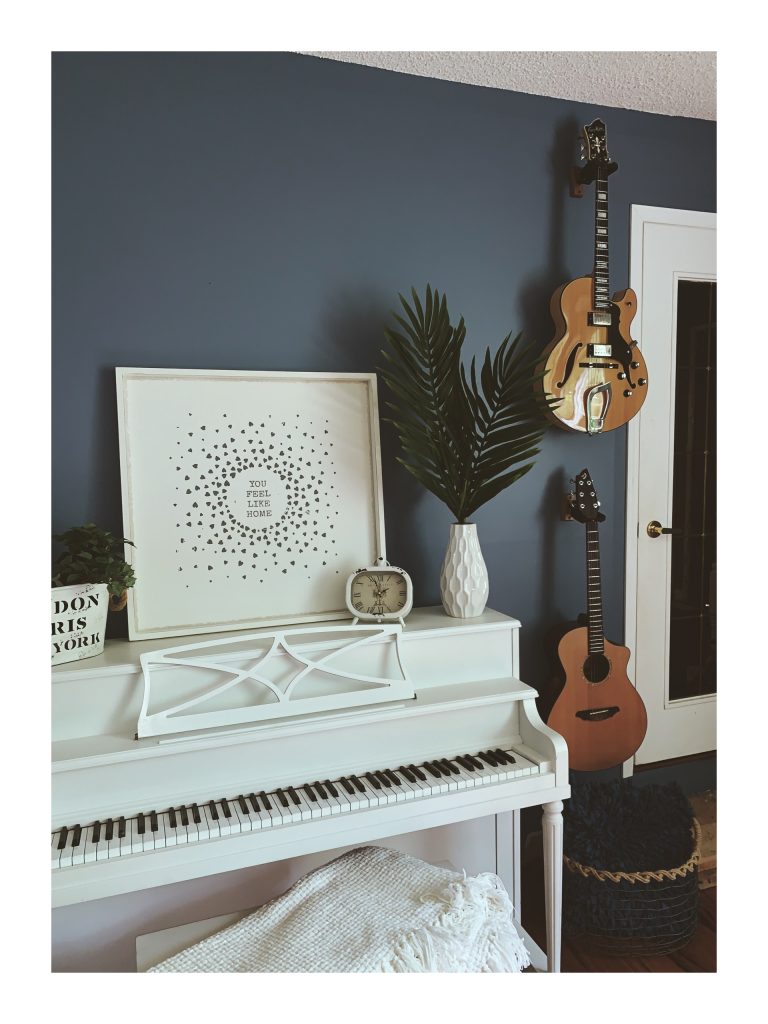When decorating a room that is intended for music, whether listening to creating it, there are a few more considerations you have to take into account that goes beyond simply needing it to look and feel nice.
From technical elements to do with sound isolation to ensuring it’s a comfortable and inspiring environment to be in that brings your most creative self to the forefront.
But the process is also a very fun one, and it’s not difficult at all to hit that nice balance between having a functional music room while still ensuring it caters to all your design needs.

So today we’re sharing our top 5 tips that will help you design your perfect music room.
Sound proofing and treatment
By far your first port of call when thinking about your music room should be soundproofing and sound treatment. This doesn’t mean your room needs to be 100% soundproof, this is an extremely difficult and expensive undertaking. But there are some nice and simple ways to reduce the amount of sound that leaks out of your room.
One of your main areas where sound will ‘leak’ from your room is through your windows, so purchasing a really nice and thick pair of soundproof curtains will go a long way to ensuring the noise stays in the room with you. A decent set of foam panels will also help with sound travelling from room to room within your house.
Another thing to consider is that the main frequencies that like to travel outside are bass frequencies. If you ever put loud music on, try placing your head right in the corner of a wall and you’ll feel the sound pressure become uncomfortably strong. To address this you can use ‘bass traps’ which are, as the name might suggest, foam ‘traps’ that you place in the corners of the room which will help tame those rogue frequencies.
Robust storage and shelving
A lot of musical equipment is heavy, the transformers in large amplifiers, huge speakers, and an ever growing record collection amounts to an incredible amount of weight that far exceeds that of a normal room.
So the last thing you want is to be enjoying some much needed musical respite after a hard day and suddenly a shelf collapses, showering both you and your room in CDs and vinyl.

This is why investing just a little more in some good, sturdy storage is going to ensure your room can handle whatever music related items you might need to store in it.
But this doesn’t need to cost much either, places such as Ikea and Home Depot offer a great range of solid, affordable, and reasonably good looking furniture and storage that is more than adequate for an average music enthusiast’s storage needs.
Using companies like this will often work out much cheaper due to ‘specialized’ musical furniture being so niche, and often hand made, that there is a huge premium in their cost.
Mood setting lighting
An often underappreciated aspect of decoration considering how much of a factor it plays in setting the mood and atmosphere of a room. Over the years we’ve seen a few design aspects become incredibly popular in music rooms and as a result, the equipment needed for them has also become much cheaper.
The main thing you will very commonly see now is LED strip lighting, people will often place this along the floor or skirting board so it projects an ambient light up the wall. Another great thing to do is line the edges of any clouds of soundboards you have with them. It adds subtle lighting that can oftentimes be the difference between an adequate environment and an inspiring one that you can’t wait to get home and relax in.
Another thing to consider is dimmable light switches that allow you to have a degree of control over the light’s intensity, which you can adjust depending on what the music calls for. Listening to high energy rock? You can have things bright and lively, relaxing to soft ambient music? Dim everything and sink into the mood a little more.
A very comfortable chair
I’m sure it sounds obvious, but much like a good mattress it’s surprising how many people will want to skimp on this area.
You’re going to spend a lot of time sitting, especially if you play an instrument. It’s incredibly easy to develop bad posture and a sore back from inadequate seating. Even if it’s a pure listening room the last thing you want is to be distracted from the music because you’re feeling sore.

If you have a studio desk ensure it has solid lumbar and neck support otherwise you’re guaranteed to get a bad back. If you spend time with a guitar or bass you may want to ensure the arms can be depressed or removed so they don’t get in the way.
Also if you plan on having any guests, remember their seats need to be comfortable too!
Finishing touches: art and greenergy
We’ve spent a lot of time covering functional things that provide some objective benefit to your room. But just as important are the purely cosmetic decorations you choose to have, this can really seal the deal in establishing a creative, relaxing, and comforting environment.
A few things you might want to consider are what you put on the walls, a hanging guitar, or a framed album can immediately set the tone as a musical room. Things like posters (especially when framed) can present something nice too.
Greenery is also something important to consider, you’ll notice the difference if you spend time in a room without greenery and one with a lot of it. You’ll feel the stale and almost clinical feeling of a room without greenery versus one that has life and vibrance to it.
Small touches like that will really elevate your room to new heights.
Conclusion
Having a room that makes you feel comfortable and inspired, that when driving home you simply can’t wait to get back to, is going to dramatically improve your experience with music, regardless of whether you are a creator or listener.
We hope these tips give you some good food for thought when thinking about what’s going to make your musical space perfect for you.
Thanks to killerguitarrigs.com for consulting on this post.
























